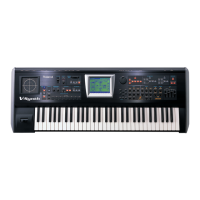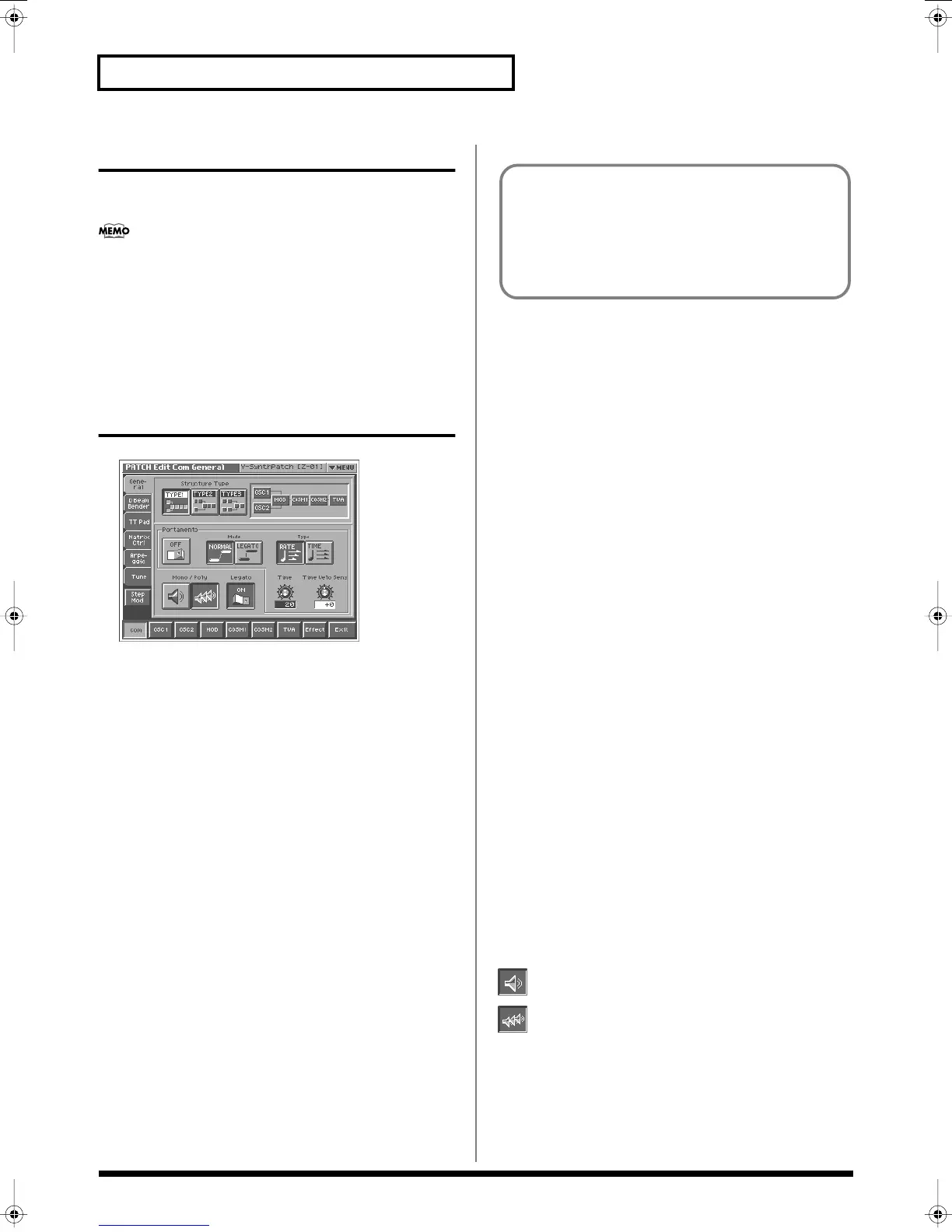78
Creating a Patch
Functions of Patch Parameters
This section explains the functions the different patch parameters
have, as well as the composition of these parameters.
Parameters marked by “
★
” can be controlled by specific MIDI
messages (Matrix Control). In the PATCH Edit Com Matrix Ctrl
screen you can specify how the parameter will be controlled (p.
80). Parameters marked by “
◆
” can be controlled by panel
buttons or knobs.
Settings Common to the Entire Patch
(Common)
General
fig.03-07_50
Structure Type
◆
Specifies how the various sound-creating elements will be combined.
Value
TYPE1:
This is the most conventional structure. Different sounds
from OSC1 and OSC2 are mixed by MOD, processed by COSM1 to
create the tonal character (e.g., using SBF (Side Band Filter)), and
then processed by COSM2 to adjust the tone (e.g., using TVF).
TYPE2:
This structure connects OSC1 and OSC2 asymmetrically.
This is effective when using a modulation that has the modulator set
to anything other than “MIX.” Typically, you will use OSC1 and
COSM1 to create the basic sound, then select the OSC2 sound and
MOD settings to add variation, and finally select TVF in COSM2 to
adjust the tone.
TYPE3:
In this structure, OSC1 is paired with COSM1, and OSC2 is
paired with COSM2. You can use a controller such as the Time Trip
Pad to morph between the sound created by OSC1 and COSM1 and
the sound created by OSC2 and COSM2.
Portamento (Portamento Switch)
Specifies whether the portamento effect will be applied (ON) or not
(OFF).
Value:
OFF, ON
Mode (Portamento Mode)
Specifies the performance conditions for which portamento will be
applied.
Value
NORMAL:
Portamento will always be applied.
LEGATO:
Portamento will be applied only when you play legato
(i.e., when you press the next key before releasing the previous key).
Type (Portamento Type)
Specifies the type of portamento effect.
Value
RATE:
The time it takes will depend on the distance between the
two pitches.
TIME:
The time it takes will be constant, regardless of how far apart
in pitch the notes are.
Time (Portamento Time)
When portamento is used, this specifies the time over which the
pitch will change. Higher settings will cause the pitch change to the
next note to take more time.
Value:
0–127
Time Velo Sens
(Portamento Time Velocity Sensitivity)
This allows keyboard dynamics to affect the portamento Time. If you
want portamento Time to be speeded up for strongly played notes,
set this parameter to a positive (+) value. If you want it to be slowed
down, set this to a negative (-) value.
Value:
-63– +63
Mono/Poly
Specifies whether the patch will play monophonically or
polyphonically. The monophonic setting is effective when playing a
solo instrument patch such as sax or flute.
Value
:
Only the last-played note will sound.
:
Two or more notes can be played simultaneously.
Portamento
Portamento is an effect which smoothly changes the pitch from
the first-played key to the next-played key. By applying
portamento when the Mono/Poly parameter is monophonic,
you can simulate slide performance techniques on a violin or
similar instrument.
Reference_e.book 78 ページ 2005年3月10日 木曜日 午後5時6分

